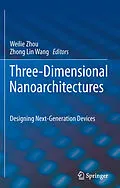Devices built from three-dimensional nanoarchitectures offer a number of advantages over those based on thin-film technology, such as larger surface area to enhance the sensitivity of sensors, to collect more sunlight to improve the efficiency of solar cells, and to supply higher density emitters for increased resolution in flat panel displays. Three-dimensional nanoscale assembly has already been used to generate many prototypes of devices and sensors, including piezoelectric nanogenerators based on ZnO nanowire arrays, photovoltaic devices based on silicon nanowire array p-n junctions, and highly sensitive gas sensors based on metal oxide nanowire arrays among others. Three-Dimensional Nanoarchitectures: Designing Next-Generation Devices describes state-of-the-art synthesis, integration, and design strategies used to create three-dimensional nanoarchitectures for functional nanodevice applications. With a focus on synthesis and fabrication methods for three-dimensional nanostructure assembly and construction, coverage includes resonators, nanophotonics, sensors, supercapacitors, solar cells, and more. This book is an essential reference for a broad audience of researchers in materials science, chemistry, physics, and electrical engineering who want the latest information on synthesis routes and assembly methods. Schematics of device integration and mechanisms as well as plots of measurement data are included.
Inhalt
1. Building Three dimensional Nanostructured Devices by Self-Assembly by Steve Hu, Jeong-Hyun Cho and David H. Gracias
Summary
1.1.0 The pressing need for three dimensional patterned nanofabrication
1.2.0 Self-assembly using molecular linkages
1.2.1 Three dimensional self-assembly using protein linkages
1.2.2 Three dimensional self-assembly with DNA linkages
1.3.0 Three dimensional self-assembly using physical forces
1.4.0 Three dimensional patterned nanofabrication by curving and bending nanostructures
1.4.1 Curving hingeless nanostructures using stress
1.4.2 Three dimensional nanofabrication by bending hinged panels to create patterned polyhedral nanoparticles
1.5.0 Conclusions
Acknowledgements
References
2. Bio-inspired Three-Dimensional Nanoarchitectures by Jian Shi and Xudong Wang
2.1 Introduction
2.2 Historical Perspective
2.3 Bio-inspired Nanophotonics
2.3.1 Photonic Crystals
2.3.2 Color Mine in Nature
2.3.3 Natural Photonic Crystals
2.4 Bio-inspired Fabrication of Nanostrctures
2.4.1 Biomineralization
2.4.2 Biological Fine Structure Duplication
2.5 Bio-inspired Functionality
2.6 Conclusion
References
3. Building 3D Micro- and Nanostructures through Nanoimprint by Xing Cheng
3.1 Introduction to 3D structure fabrication through nanoimprint
3.2 Overview of nanoimprint lithography
3.2.1 Fundamentals of nanoimprint lithography
3.2.2 Materials for nanoimprint lithography]
3.3 Building 3D Nanostructures by Nanoimprint
3.3.1 Direct patterning of 3D structures in one step
3.3.1.1 Replicating 3D polymer structures from 3D templates
3.3.1.2 Applications of 3D polymer structures by one-step nanoimprint
3.3.2 Building 3D nanostructures by transfer bonding and sequential layer stacking
3.3.2.1 Principles of transfer bonding and sequential layerstacking
3.3.2.2 3D structures built by transfer bonding and sequential layer stacking
3.3.2.3 Defect modes and process yield of transfer bonding and sequential layer stacking
3.3.3 Building 3D nanostructures by two consecutive nanoimprints
3.4 Summary and future outlook
References
4. Electrochemical Growth of Nanostructured Materials by Jin-Hee Lim and John B. Wiley
4.1 Magnetic Nanomaterials
4.2 Semiconductor Nanostructures
4.3 Thermoelectric Nanomaterials
4.4 Conducting Polymer Nanostructures
4.5 Nanotube and Core-Shell Nanostructures
4.6 Porous Au Nanowires
4.7 Modification of Nanowires
4.8 Functionalization of Nanowires
4.9 Nanostructure Arrays on Substrates
4.10 Patterning of Nanowires
Acknowledgment
5. Three dimensional micro/nanomaterials generated by fiber drawing nanomanufacturing by Zeyu Ma, Yan Hong, Shujiang Ding, Minghui Zhang, Maniul Hossain, Ming Su
5.1 Introduction
5.2 Fiber draw tower
5.3 Materials selections
5.4 Drawing process
5.5 Size design
5.6 3D assembling
5.7 Metallic nanowires
5.8 Semiconductor nanowires
5.9 Glass microchannel array
5.10 Differential etching of glasses
5.11 Glass microspike array
5.12 Hybrid glass membranes
5.13 Textured structure of encapsulated paraffin wax microfiber
5.14 Conclusions
References
6.0 One-Dimensional Metal Oxide Nanostructures for Photoelectrochemical Hydrogen Generation by Yat Li
6.1 Introduction
6.1.1 Photoelectrochemical hydrogen generation6.1.2 Challenges in Metal Oxide based PEC hydrogen generation
6.1.3 One-Dimensional Nanomaterials for Photoelectrodes
6.2 Pristine Metal Oxide Nanowire/Nanotube-Arrayed Photoelectrodes
6.2.1 Nanowire arrayed photoelectrodes
6.2.1.1 Hematite (-Fe2O3)
6.2.1.2. Titanium Oxide (TiO2) and Zinc Oxide (ZnO)6.2.1.3. Tungsten Trioxide (WO3)
6.2.2 Nanotube arrayed photoelectrodes
6.3 Element-Doped Metal Oxide 1D Nanostructures
6.3.1 TiO2 nanostructures
6.3.2. ZnO nanostructures
6.3.3 Hematite (-Fe2O3) nanostructures
6.4 Quantum Dot Sensitizations
6.4.1 Background
6.4.2 Quantum Dot Sensitized ZnO Nanowires
6.4.3 Quantum Dot Co-Sensitized Nanowires
6.4.4 Double-sided Qua...
